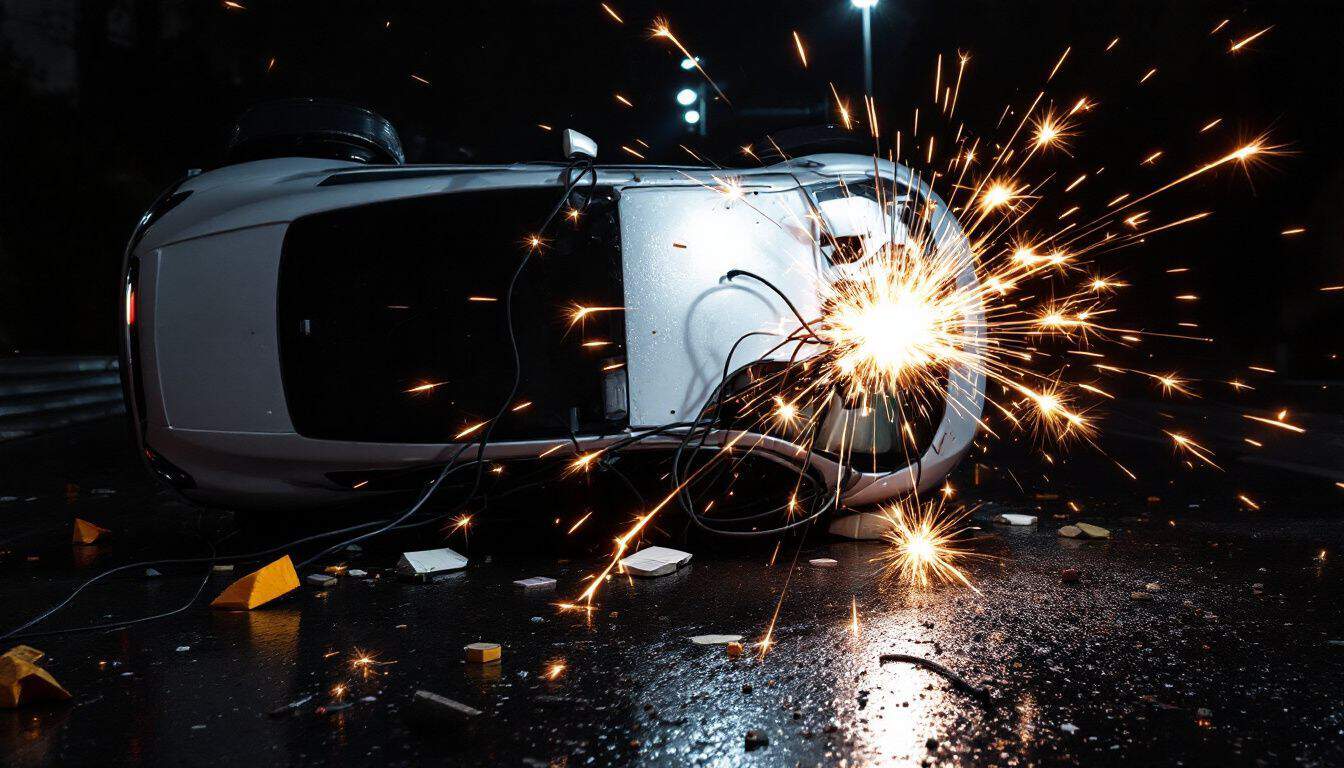Electric car crashes are on the rise. Did you know that EV accidents jumped by 30% last year? This blog will shed light on five hidden dangers every electric vehicle owner should know.
Buckle up – it’s time to get smart about EV safety.
Key Takeaways
Electric car crashes jumped 30% last year, with EVs causing 50% more accidents than gas cars.
EVs weigh up to 33% more than gas cars, leading to stronger crash forces and potentially worse injuries.
EV batteries can catch fire after crashes, burning hotter and longer than gas fires.
Insurance companies are raising premiums for EVs due to higher repair costs, with minor fender benders costing $3,000-$5,000 to fix.
Safety agencies are updating testing standards for EVs, focusing on battery safety and computer systems in crashes.
Table of Contents
Analyzing the Surge in Electric Car Crash Incidents

Electric cars are crashing more often. Data shows a spike in EV accidents over the past few years.
Trends in Electric Vehicle Accidents
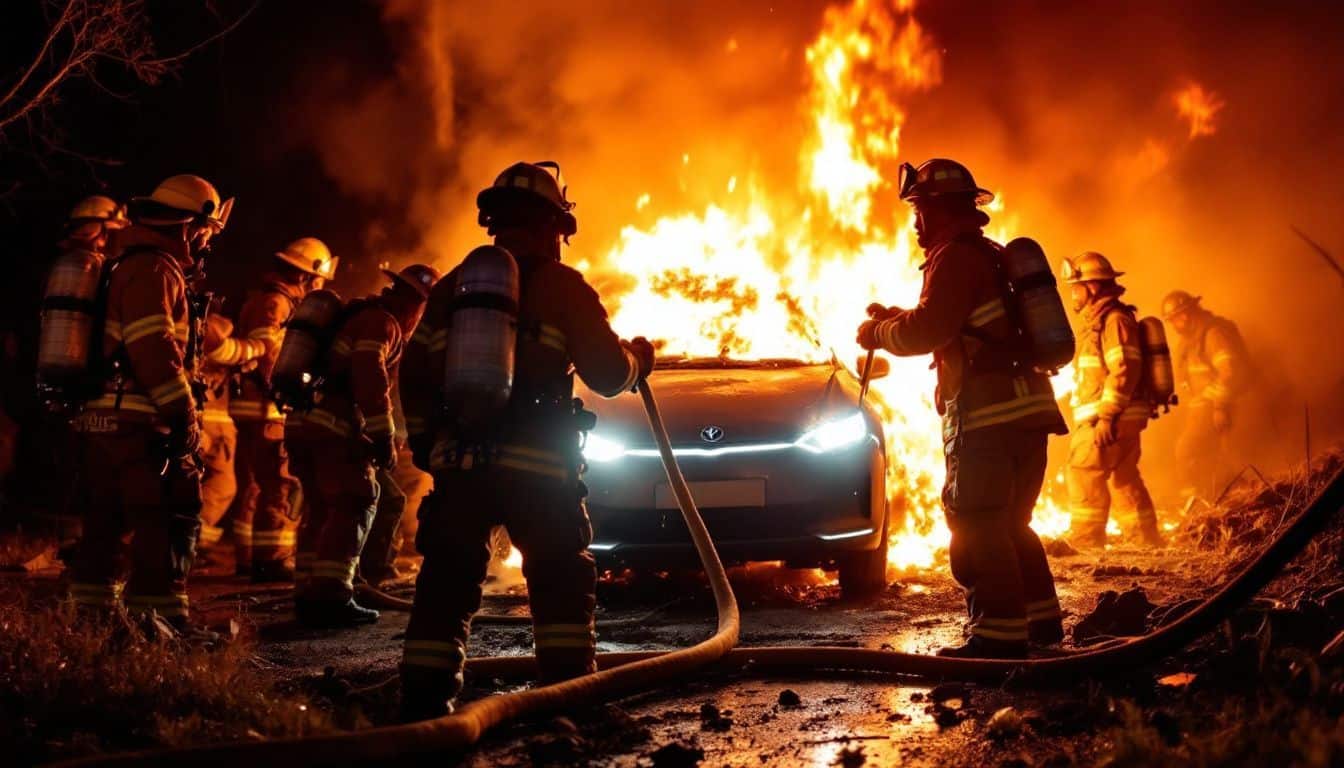
Buckle up, gents! Let’s dive into the wild world of electric vehicle (EV) crashes. They’re not your grandpa’s fender benders, that’s for sure. Here’s the lowdown on what’s happening out there:
| Trend | Details |
|---|---|
| Speed Demons | The NTSB found that going too fast was likely behind a deadly EV crash in Fort Lauderdale. Turns out, instant torque can be a double-edged sword. |
| Battery Blazes | Post-crash fires from those lithium-ion powerhouses can make injuries worse. These babies burn hotter and longer, giving firefighters a run for their money. |
| Heavyweight Champs | EVs can weigh up to 33% more than gas guzzlers. More mass means bigger crash forces – it’s just physics, fellas. |
| Safety Surprise | Plot twist! Insurance data shows EV owners file fewer injury claims. Looks like these high-tech rides are keeping us safer after all. |
| Rare Fires | Tesla boasts just five fires per billion miles driven. That’s pretty darn good, considering how much we hear about EV fires in the news. |
| Legal Tangles | EV accidents bring new twists to courtrooms. Think battery fire risks and potential zaps from exposed wires. Lawyers are gonna have a field day with this stuff. |
So there you have it, guys. EV crashes are a whole new ballgame. Stay sharp out there – and maybe ease off that accelerator a bit, yeah?
Key Factors Driving Increased Crash Rates
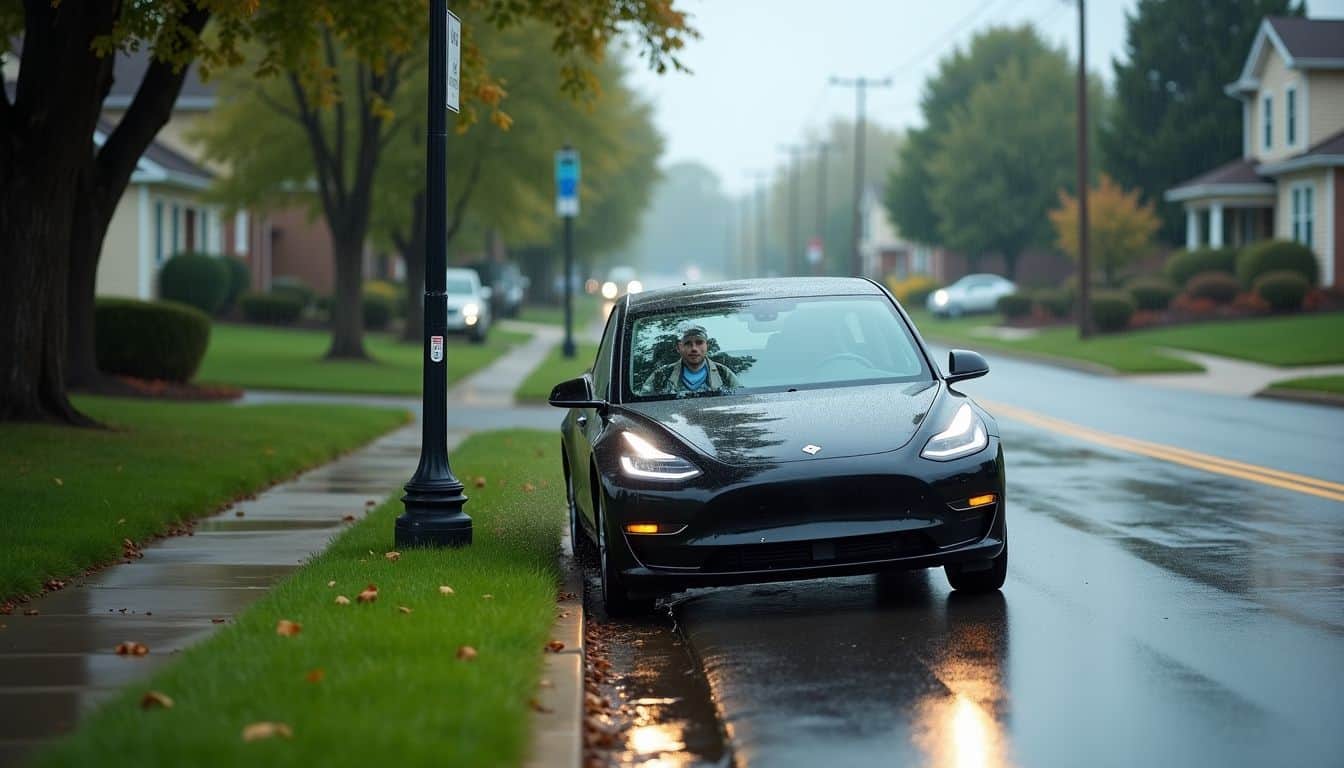
Electric cars are zipping into more crashes these days. Why? Well, they’re just so darn quick! These zippy rides can go from zero to sixty in a flash, tempting drivers to speed up.
But here’s the kicker – speeding is a major cause of losing control and crashing. Plus, electric vehicles (EVs) are heavier than gas cars, packing up to 33% more weight. That extra heft means more force in a crash, making accidents nastier.
Speed thrills, but it also kills.
Drivers of electric cars are causing half again as many crashes as their gas-guzzling buddies
By 2030, experts think 40% of all new cars sold will be electric. More EVs mean more EV crashes – it’s simple math. So, while these cars are great for the planet, they’re giving safety folks some new headaches to solve.
Examining Unique Risks of Electric Cars

Electric cars pack some hidden punches. Their hefty weight and powerful batteries bring fresh risks to the road.
The Impact of Greater Vehicle Weight
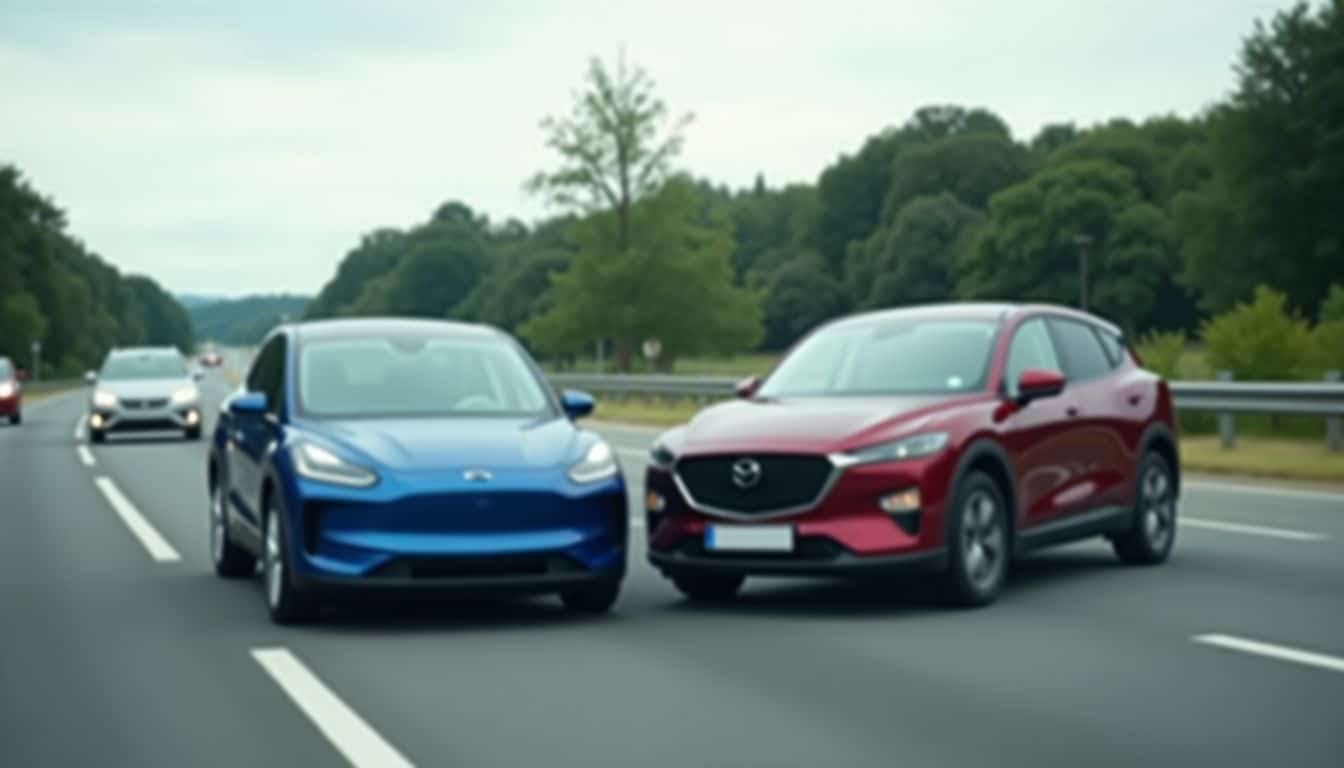
Electric cars pack on the pounds. They can weigh up to a third more than gas cars. This extra heft means they hit harder in crashes. Think of it like a big guy bumping into you – it’s gonna hurt more than if a skinny dude did it.
The bigger mass also changes how EVs react in accidents. They don’t crumple the same way lighter cars do.
This weight issue isn’t just about fender benders. It affects highway safety big time. Heavier cars need stronger guardrails and crash barriers. The old ones might not cut it anymore.
And when an EV hits another car, watch out! That extra force can really do a number on the other vehicle. It’s like David vs. Goliath, but on the road.
Safety Concerns with Electric Car Batteries
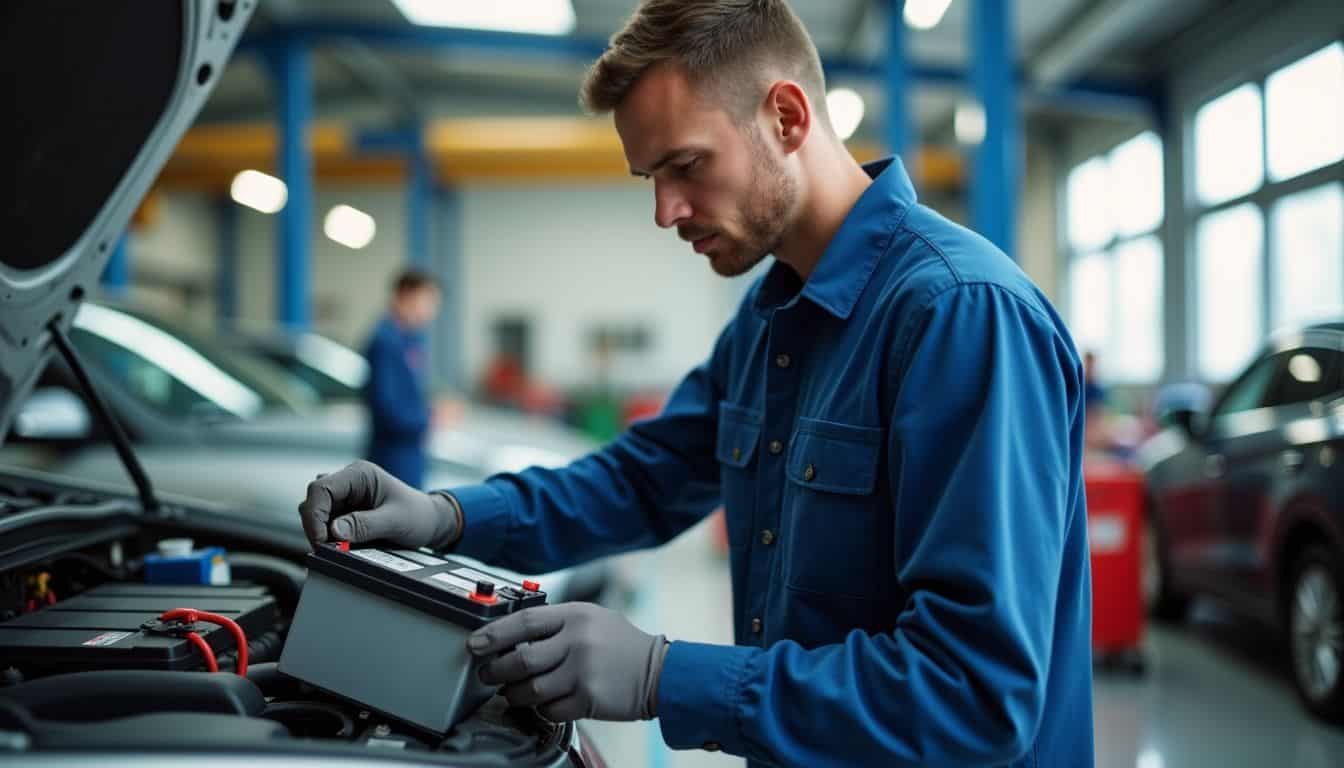
Electric car batteries pack a punch… and some risks. Lithium-ion batteries can catch fire in crashes, burning hotter and longer than gas fires. In Fort Lauderdale, firefighters doused an EV’s interior blaze in just a minute.
But the danger wasn’t over. Battery parts can reignite when tow trucks move the wreck. It’s rare, but it happens.
Car makers aren’t sitting idle, though. They’ve added smart tech to EVs. Sensors and circuit breakers cut power to batteries in crashes. It’s like having a built-in firefighter. Still, EV owners should know the drill.
If your car catches fire, get out fast. Let the pros handle it. Safety first, always.
Implications for Law and Insurance
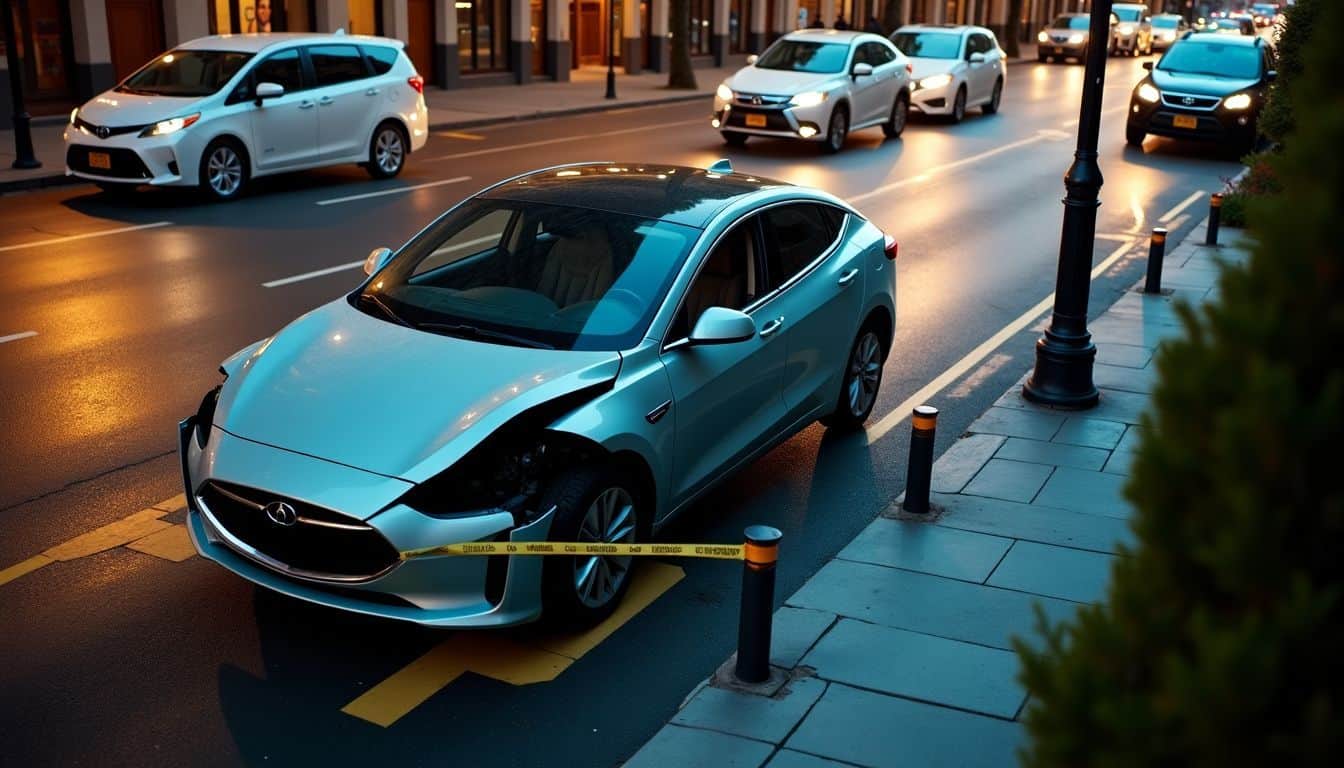
Electric car crashes are shaking up the legal world. Insurance companies are scrambling to figure out new rules for these high-tech rides.
Assessing Liability in Electric Car Crashes

Figuring out who’s at fault in electric car crashes can be tricky. It’s not just about the drivers anymore. Now, we’ve got to think about the car’s electric system and battery too.
These high-tech parts can malfunction, causing accidents that weren’t anyone’s fault. And let’s not forget about those scary battery fires – they’re a whole new ballgame in crash liability.
Electric vehicles bring new challenges to determining liability, as complex as the technology itself.
Legal experts are puzzled by these new issues. Who’s to blame if a battery catches fire after a minor bump? What if the car’s computer goes haywire? It’s a tangle of questions that need answers.
If you’re in a tough spot after an EV crash, getting legal guidance for electric car crashes might be your best move.
The rules are changing, and you’ll want someone who understands the ins and outs.
Adjustments in Insurance for Electric Vehicle Risks

Electric cars are shaking up the insurance world. Companies are scrambling to update their policies for these high-tech rides.
- Heavier Hits: EVs pack more weight, so crashes pack more punch. Insurance firms are upping premiums to cover the extra oomph in collisions.
- Battery Blazes: Those lithium-ion power packs can turn into fireballs. Insurers are adding special coverage for these unique infernos.
- Zap Hazards: First responders face new dangers from electric shocks. Policies now include extra protection for emergency crews.
- Repair Costs: Fixing a damaged EV isn’t cheap. Insurance rates are climbing to match the pricey parts and specialized mechanics.
- Legal Tangles: Battery fires and shock risks create tricky lawsuits. Insurers are beefing up liability coverage to handle these electric curveballs.
- Occupant Safety Surprise: EV drivers and passengers get hurt less in crashes. This oddity is making insurers rethink how they set rates.
- Tech Troubles: Advanced features like lane assist can malfunction. New policies cover glitches in these fancy gadgets.
- Charging Snafus: Faulty charging stations can damage cars. Insurance now includes protection against power-up problems.
- Silent Menace: EVs’ quiet nature poses risks to pedestrians and cyclists. Policies are expanding to cover accidents caused by the stealth factor.
- Data Dilemma: EVs collect tons of info. Insurers are figuring out how to use this data goldmine while respecting privacy.
Comparative Safety Analysis
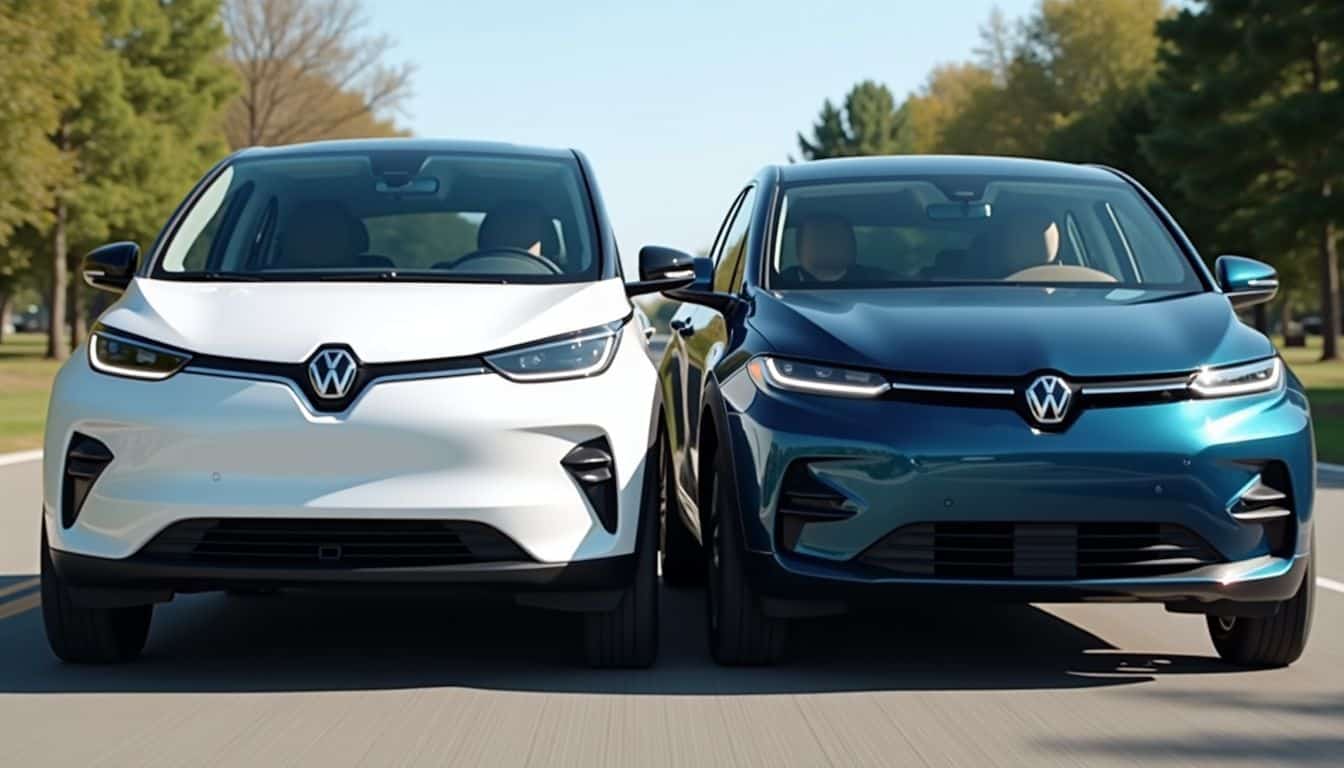
Let’s stack up EVs against gas guzzlers. We’ll crunch the numbers on crash stats and repair costs – and see how safety standards are shifting gears.
Electric vs. Traditional Vehicle Crash Statistics
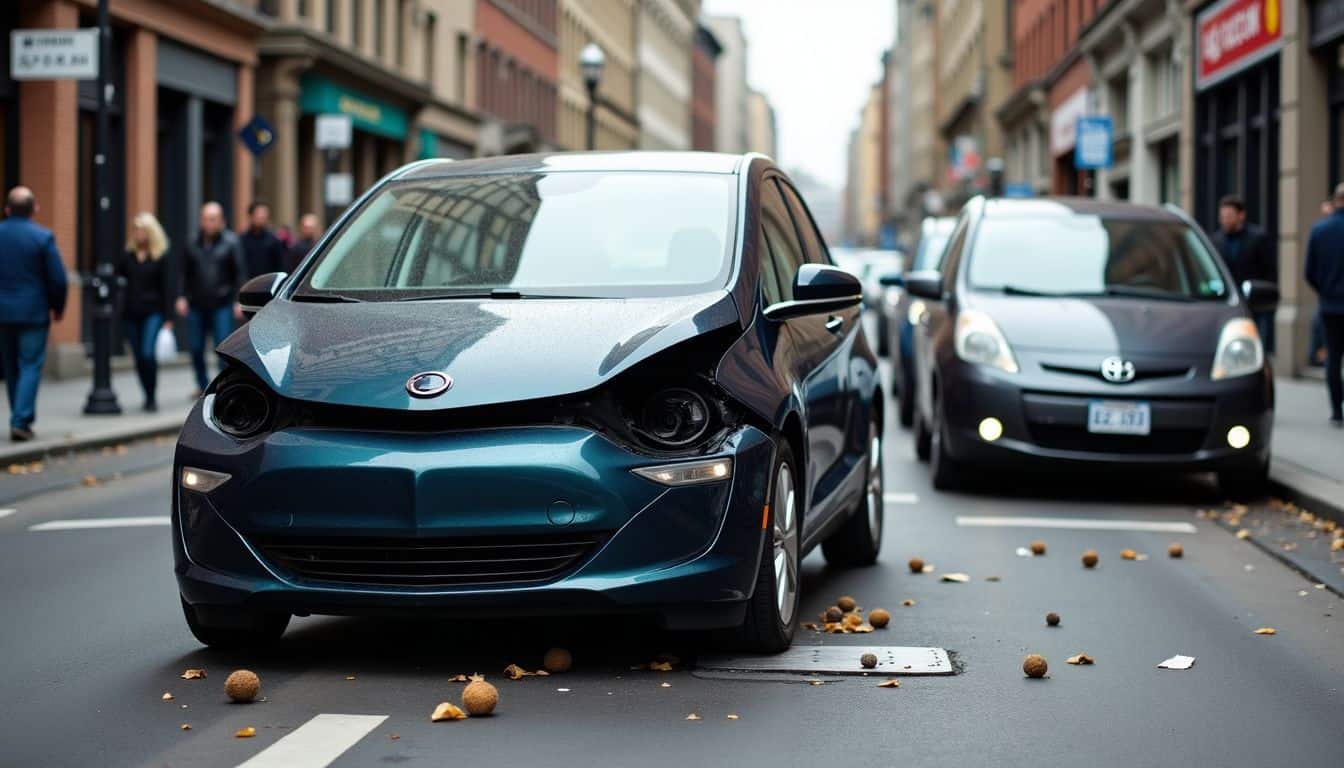
Crashes in electric vehicles (EVs) and traditional cars tell different stories. Let’s break it down in simple terms.
| Aspect | Electric Vehicles | Traditional Vehicles |
|---|---|---|
| Injury Claims | Below-average | Higher |
| Fire Risk | Lower (5 fires per billion miles) | Higher |
| Vehicle Damage | 50% more likely | Less likely |
| Weight | Up to 1/3 heavier | Lighter |
| Safety Features | Advanced sensors, circuit breakers | Standard safety features |
Surprising, right? EVs seem safer in many ways. They’re less likely to catch fire or hurt you in a crash. But there’s a catch – they’re more prone to damage. Why? Those zippy accelerations can lead to more fender benders.
Here’s a personal tidbit: I once saw an EV crash. The car was a mess, but the driver walked away without a scratch. It’s like those cars are built like tanks… with cushions inside.
The extra weight of EVs is a double-edged sword. It makes them sturdier, but it also means they hit harder in a crash. It’s like the difference between getting tackled by a linebacker versus a quarterback.
But don’t worry, EV makers are on top of it. They’re adding high-tech safety gear to these cars. Sensors that’d make a spy jealous and circuit breakers that cut power faster than you can say “oops”.
So, what’s the bottom line? EVs are generally safer, but they’re not invincible. They’ve got their own quirks and risks. But hey, that’s just part of the electric revolution, right? Buckle up and enjoy the ride!
Cost Analysis of EV Accident Repairs
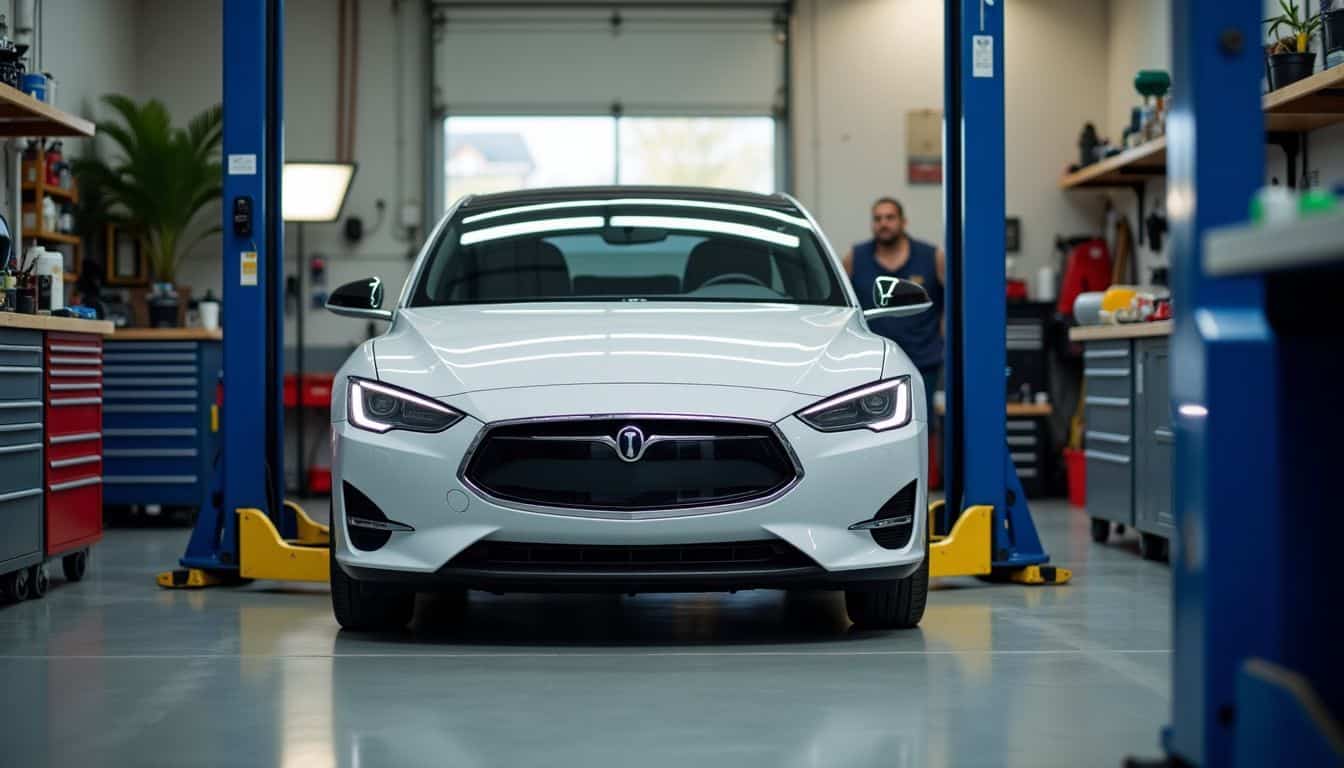
Moving from crash statistics, let’s talk money. Fixing up an electric car after a fender bender? It’s not cheap, fellas.
Here’s a breakdown of repair costs for EVs compared to gas cars:
| Repair Type | Electric Vehicle | Gas Vehicle |
|---|---|---|
| Minor Fender Bender | $3,000 – $5,000 | $1,500 – $3,000 |
| Battery Replacement | $5,000 – $15,000 | N/A |
| Major Collision | $10,000 – $30,000+ | $5,000 – $15,000 |
Ouch! Those numbers sting. Why so high? It’s all about the tech, boys. EVs pack fancy batteries and intricate systems. Fixing them takes special know-how and pricey parts.
I learned this the hard way with my Genesis GV60 electric car. A small bump turned into a big bill. The shop needed special tools just to check the battery.
Insurance companies are catching on, too. They’re increasing premiums for EVs. It’s not all bad news, though. As more EVs hit the road, repair costs might drop. For now, budget extra for those “just in case” moments.
Drive safe, and keep your wallet happy.
Safety Ratings and Testing Standards Evolution
Safety ratings for electric cars have come a long way. Back in the day, we didn’t know much about how these new rides would hold up in crashes. But now, things are different. Car makers and safety groups have stepped up their game.
They’re always coming up with new ways to test EVs. They look at stuff like battery fires and how the extra weight affects crashes. It’s not just about crash test dummies anymore.
The rules are changing too. Agencies like the NHTSA are updating their standards. They want to make sure EVs are as safe as regular cars – or even safer. Some tests now focus on how well the battery holds up in a crash.
Others check if the car’s computers can handle a hit. It’s all about keeping drivers and passengers safe on the road. And as EVs get more popular, you can bet these tests will keep getting tougher.
People Also Ask
Are electric cars more likely to catch fire in crashes?
Electric vehicles don’t catch fire more often than gas cars. But their lithium-ion batteries can be tricky to put out if they do ignite. Firefighters need special training for EV fires.
Do heavier EVs pose a bigger threat on the road?
Yes, some EVs like the GMC Hummer EV are much heavier than regular cars. This extra weight can be tough on roads and guardrails. It also means more force in a crash, which could hurt others.
How do EVs perform in crash tests?
Many EVs do well in crash tests. The Insurance Institute for Highway Safety (IIHS) gives top marks to several Tesla models. But EV makers still need to work on protecting cyclists and pedestrians.
Can EV batteries explode during a collision?
EV batteries rarely explode. But they can leak, smoke, or reignite hours after a crash. This is why the National Transportation Safety Board suggests parking damaged EVs away from buildings.
Are EV insurance premiums higher due to crash risks?
Sometimes. Insurers may charge more for EVs because of pricey battery packs and repair costs. But as EVs become more common, these costs might go down.
How are car makers improving EV safety?
Automakers are beefing up battery protection and adding new safety tech. They’re also working with groups like the Midwest Roadside Safety Facility to make EVs play nice with traffic barriers and medians.
